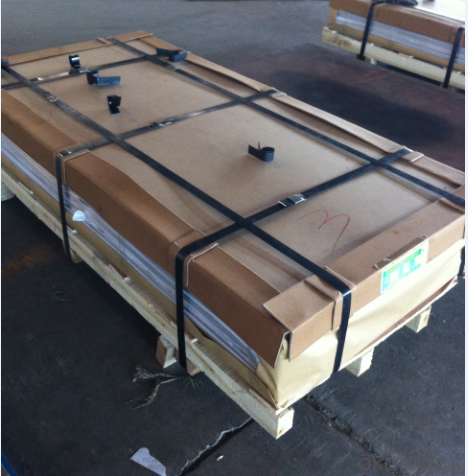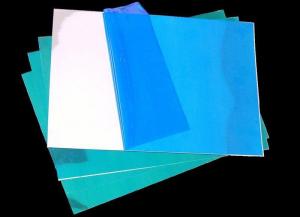1100-H124 aluminium sheet and aluminium slab in warehouse
- Loading Port:
- Shanghai
- Payment Terms:
- TT OR LC
- Min Order Qty:
- 1 m.t
- Supply Capability:
- 3000 m.t/month
OKorder Service Pledge
OKorder Financial Service
You Might Also Like
1.Structure of Product Description
Cold rolled aluminum sheet is widely used in the field of construction field and decoration field, etc.
There are many different grades, such as: 1000 series, 2000 series, 3000 series, 5000 series, 6000series, etc. The detailed grade are as follows: 1010, 1050,1060,1100, 2024, 3003, 3005, 3105, 5052,5754,5083,6061,6063,8011, etc.
The temper is include H14, H22, H24, H44,H112,H114,etc.
2. Main features of the product
a.Competitive price
b.Frist-Class Service.
c. Shortest service.
3. Image

4. Product detailed sizes:
1000mm*2000mm, 1219mm*2438mm,1220mm*2440mm, 1250mm*2500mm,1500mm*3000mm, etc.
5. FAQ:
What is the quality standard?
---Usually our standard is GB3880-2006 or others.
What is the width range?
---It is from 1000mm to 2500mm, etc.
What is the length range:
---It is from 2000mm to 6000mm, etc.
- Q:Can 101 aluminum sheets be polished to a mirror-like finish?
- Yes, 101 aluminum sheets can be polished to a mirror-like finish. Aluminum is a highly malleable and lightweight metal that can be easily polished to achieve a reflective surface. However, the process of achieving a mirror-like finish on aluminum requires several steps and the use of appropriate polishing techniques and materials. To polish aluminum sheets to a mirror-like finish, you would typically start by cleaning the surface thoroughly to remove any dirt, debris, or oxidation. Next, you would need to sand the surface using progressively finer grits of sandpaper to remove any imperfections or scratches. This step is crucial to create a smooth and even surface that can be polished to a high shine. After sanding, you would move on to the polishing stage. There are various methods and materials that can be used for polishing aluminum, including abrasive compounds, buffing wheels, and polishing pads. These tools are used to apply pressure and friction to the aluminum surface, which helps to remove any remaining scratches and imperfections and create a smooth, reflective finish. Finally, to achieve a true mirror-like finish, a process called buffing or burnishing is often employed. This involves using a soft cloth or a specialized buffing wheel to apply a polishing compound to the surface of the aluminum. The compound helps to further refine the surface and enhance its reflective properties, resulting in a mirror-like finish. It's worth noting that achieving a mirror-like finish on aluminum can be a time-consuming and labor-intensive process, especially when dealing with a large number of sheets like 101. Additionally, the quality of the aluminum sheets themselves and the skill level of the person performing the polishing can also influence the final result. However, with the right materials, techniques, and patience, it is indeed possible to polish 101 aluminum sheets to a mirror-like finish.
- Q:Do aluminum cans melt in typical campfires? I know the melting point is about 660 Celsius but do campfires get that high? I thought it would just be that the can becomes disfigured and collapses due to the heat, not due to it melting. Even if it did melt in the fire how would you find the remains? The can in a liquid form would certainly not be confined to one part of the fire and therefore wouldn't solidify in a small pool to see if it had melted or not. Any ideas?
- Aluminium is very easily oxidized (in its solid form, a thin layer of very though aluminium oxide protects the metal). Put it in a fire, and that oxide will be removed, and 100% of the metal will oxidize, leaving nothing but aluminium oxide white powder behind.
- Q:... initial temperature of the water or the initial temperature of the aluminum? Why?
- The correct equation is: dQ = m*c*dT As dQ (substitute of thermal potential) and mass are the comparable, the equation may well be rewritten as: c*dT=consistent So a cloth with a decrease specific warmth skill could have a much better improve in temperature. The question has already suggested this yet now all of us be attentive to they are inversely proportional. to that end: c of aluminium/c of copper = dT of aluminium / dT of copper 0.22/0.092 = proportionality consistent = 2.39 So copper would be 2.4 circumstances warmer than aluminium (or aluminium would be 0.40 two circumstances warmer than copper).
- Q:What are the different packaging options available for aluminum sheets during transportation?
- To ensure the safety and intactness of aluminum sheets during transportation, various packaging options are available. Some commonly employed choices are: 1. Wooden Crates: Strong and durable wooden crates offer formidable protection against impacts and rough handling. These crates can be tailored to the size and weight of the sheets. 2. Cardboard Boxes: For smaller quantities or sheets of smaller sizes, cardboard boxes are a popular option. The sheets are stacked and securely packed inside the boxes, which are then sealed to prevent movement or damage during transit. 3. Pallets: Wooden or plastic platforms called pallets provide convenient handling and transportation. The sheets are stacked and fastened to the pallets using straps, ensuring stability and protection during shipping. 4. Stretch Wrap: Another alternative is to tightly wrap the aluminum sheets together using a plastic film. This stretch wrap secures the sheets in place, shielding them from scratches and minor damages. 5. Protective Film: It is common practice to apply a protective film on the surface of the aluminum sheets before packaging. This film acts as a barrier, safeguarding against moisture, dust, and scratches during transportation. 6. Edge Protectors: To prevent damage to the edges of the aluminum sheets, edge protectors made of plastic or cardboard can be used. These protectors absorb impacts, ensuring the sheets remain intact. 7. Customized Packaging: Depending on the specific requirements and transportation method, customized packaging solutions can be devised. Foam inserts, dividers, or additional cushioning materials can be utilized to provide maximum protection during transit. Choosing the appropriate packaging option is crucial and should be based on factors such as size, weight, fragility of the aluminum sheets, mode of transportation, and distance to be traveled. Proper packaging is paramount in preventing damage and ensuring the sheets arrive at their destination in optimal condition.
- Q:Are the aluminum sheets suitable for manufacturing electrical enclosures?
- Indeed, aluminum sheets prove to be a suitable material for the production of electrical enclosures. Within the manufacturing industry, aluminum is widely utilized due to its versatility and numerous advantages. To begin with, aluminum possesses a unique combination of lightweight properties and strength, making it an ideal choice for constructing enclosures that require durability without the burden of excessive weight. Its strength-to-weight ratio surpasses that of many other metals, allowing for the creation of sturdy enclosures without unnecessary bulkiness. Moreover, aluminum exhibits exceptional resistance to corrosion, a crucial attribute for electrical enclosures that may encounter various environmental conditions, such as moisture, humidity, or corrosive elements. The natural oxide layer present on aluminum acts as a protective barrier, ensuring the enclosures' longevity and reliability. Additionally, aluminum possesses excellent electrical conductivity, a vital characteristic for electrical enclosures. This property facilitates efficient dissipation of heat generated by electrical components, effectively preventing overheating and potential damage to the enclosed devices. Furthermore, aluminum is highly machinable and can be easily molded into different shapes and sizes. This inherent flexibility enables manufacturers to customize the enclosures according to specific requirements, ensuring a perfect fit for the intended electrical components. Finally, when considering cost-effectiveness, aluminum proves to be a more economical choice compared to other metals such as stainless steel or copper. It strikes a balance between affordability and performance, making it an attractive option for the manufacturing of electrical enclosures. In conclusion, the lightweight nature, strength, corrosion resistance, electrical conductivity, machinability, and cost-effectiveness of aluminum sheets make them a highly suitable material for the production of electrical enclosures.
- Q:combines with oxygen with an atomic weight of 16, to form the compound aluminum oxide, how much oxygen would be required to react completely with 54g of aluminum?
- aluminum oxide is Al2O3 , or 2 part Al to 3 part O. 27 grams Al2 *2 / 54 grams Al available = 16 grams of O * 3 / X grams of O solve for X: X = 48 grams of oxygen needed next guy is right....the formula for aluminum oxide is Al2O3..sorry...I readjusted the formula above to show the change
- Q:Are aluminum sheets suitable for water storage applications?
- Yes, aluminum sheets are suitable for water storage applications. Aluminum is a corrosion-resistant material and does not rust, making it ideal for storing water without any negative impact on its quality. Additionally, aluminum sheets are lightweight, durable, and easily moldable, allowing for the construction of various water storage containers and tanks.
- Q:How much is a square inch of a millimeter aluminum plate?
- Make a supplement to the answer on the first floorSo-called:1 lines, when referring to pure aluminum, that is, aluminum content is not less than 99%., weight 2.71 kg / square meterThe 3 Series refers to manganese as the main alloying element, that is, aluminum manganese alloy.
- Q:Are aluminum sheets suitable for food-grade applications?
- Yes, aluminum sheets are suitable for food-grade applications. Aluminum is a non-toxic and non-reactive metal, making it safe for direct contact with food. It is also lightweight, durable, and resistant to corrosion, making it an ideal choice for various food-related uses such as packaging, cooking utensils, and food processing equipment.
- Q:Are aluminum sheets suitable for high-pressure environments?
- Aluminum sheets are generally not suitable for high-pressure environments as they have a relatively low strength-to-weight ratio compared to other materials. This means that they may deform or fail under high pressure, leading to potential safety risks. Additionally, aluminum has a relatively low melting point, which can further compromise its structural integrity in high-pressure situations. In such environments, materials with higher strength and resistance to deformation, such as steel or titanium, are typically preferred.
1. Manufacturer Overview |
|
|---|---|
| Location | |
| Year Established | |
| Annual Output Value | |
| Main Markets | |
| Company Certifications | |
2. Manufacturer Certificates |
|
|---|---|
| a) Certification Name | |
| Range | |
| Reference | |
| Validity Period | |
3. Manufacturer Capability |
|
|---|---|
| a)Trade Capacity | |
| Nearest Port | |
| Export Percentage | |
| No.of Employees in Trade Department | |
| Language Spoken: | |
| b)Factory Information | |
| Factory Size: | |
| No. of Production Lines | |
| Contract Manufacturing | |
| Product Price Range | |
Send your message to us
1100-H124 aluminium sheet and aluminium slab in warehouse
- Loading Port:
- Shanghai
- Payment Terms:
- TT OR LC
- Min Order Qty:
- 1 m.t
- Supply Capability:
- 3000 m.t/month
OKorder Service Pledge
OKorder Financial Service
Similar products
New products
Hot products
Related keywords





























